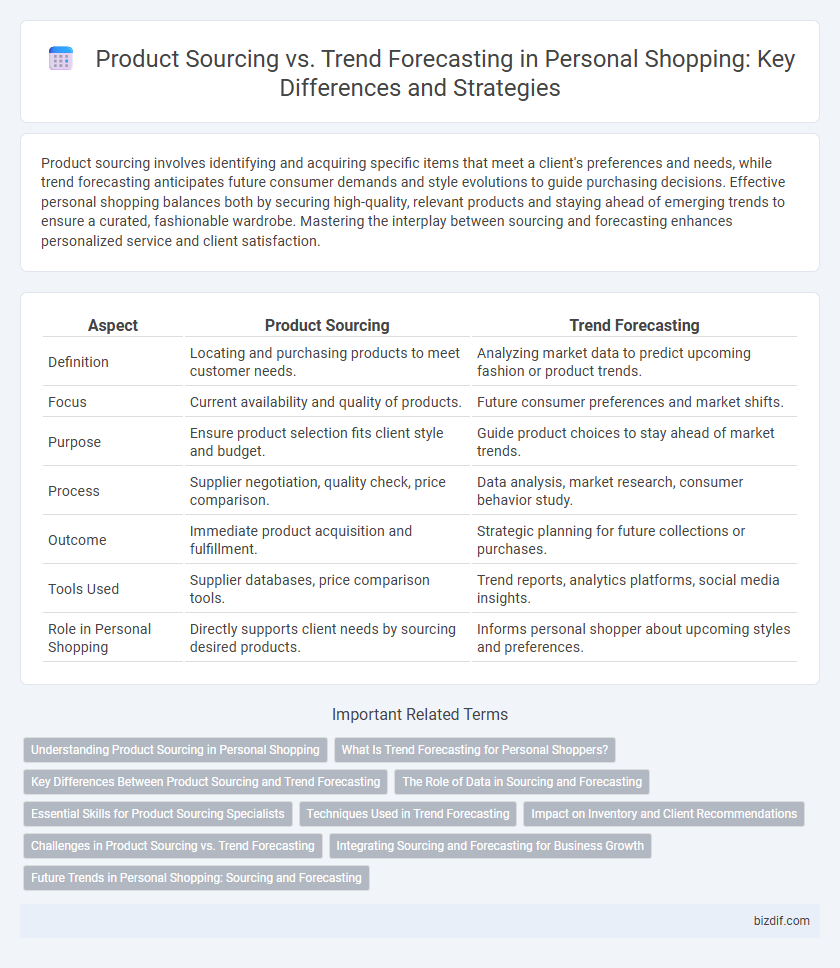Product sourcing involves identifying and acquiring specific items that meet a client's preferences and needs, while trend forecasting anticipates future consumer demands and style evolutions to guide purchasing decisions. Effective personal shopping balances both by securing high-quality, relevant products and staying ahead of emerging trends to ensure a curated, fashionable wardrobe. Mastering the interplay between sourcing and forecasting enhances personalized service and client satisfaction.
Table of Comparison
| Aspect | Product Sourcing | Trend Forecasting |
|---|---|---|
| Definition | Locating and purchasing products to meet customer needs. | Analyzing market data to predict upcoming fashion or product trends. |
| Focus | Current availability and quality of products. | Future consumer preferences and market shifts. |
| Purpose | Ensure product selection fits client style and budget. | Guide product choices to stay ahead of market trends. |
| Process | Supplier negotiation, quality check, price comparison. | Data analysis, market research, consumer behavior study. |
| Outcome | Immediate product acquisition and fulfillment. | Strategic planning for future collections or purchases. |
| Tools Used | Supplier databases, price comparison tools. | Trend reports, analytics platforms, social media insights. |
| Role in Personal Shopping | Directly supports client needs by sourcing desired products. | Informs personal shopper about upcoming styles and preferences. |
Understanding Product Sourcing in Personal Shopping
Product sourcing in personal shopping involves identifying and acquiring products that align with a client's unique preferences, budget, and lifestyle, ensuring a personalized and efficient shopping experience. It requires deep knowledge of suppliers, market availability, quality standards, and pricing strategies to deliver tailored recommendations. Unlike trend forecasting, which predicts future market demands and style directions, product sourcing focuses on the immediate selection and procurement of items that meet the client's current needs.
What Is Trend Forecasting for Personal Shoppers?
Trend forecasting for personal shoppers involves analyzing consumer behavior, market data, and emerging styles to predict upcoming fashion trends. This process helps personal shoppers recommend timely, relevant products to clients, ensuring wardrobes remain stylish and aligned with future tastes. Unlike product sourcing, which focuses on acquiring specific items, trend forecasting emphasizes anticipating shifts in preferences to guide strategic purchasing decisions.
Key Differences Between Product Sourcing and Trend Forecasting
Product sourcing involves identifying and acquiring specific products to meet consumer demand, emphasizing supplier relationships, cost efficiency, and inventory management. Trend forecasting predicts future market trends and consumer preferences by analyzing data, cultural shifts, and emerging patterns to guide strategic decisions. Key differences lie in their focus: product sourcing is tactical and execution-oriented, while trend forecasting is strategic and insight-driven.
The Role of Data in Sourcing and Forecasting
Data analytics drives efficiency in personal shopping by enabling precise product sourcing and accurate trend forecasting, leveraging consumer behavior patterns and market insights. Advanced algorithms analyze large datasets to predict emerging trends and identify optimal suppliers, reducing inventory risks and enhancing customer satisfaction. Integrating real-time sales data with social media sentiment provides a comprehensive approach to meeting evolving consumer demands.
Essential Skills for Product Sourcing Specialists
Product sourcing specialists excel in supplier negotiation, cost analysis, and quality assurance to secure the best merchandise for personal shopping clients. Mastery in inventory management and market research enables them to identify reliable sources and ensure timely delivery. Expertise in understanding customer preferences combined with strong logistical coordination distinguishes effective product sourcing professionals in the competitive retail landscape.
Techniques Used in Trend Forecasting
Trend forecasting in personal shopping relies heavily on techniques such as data analytics, social media monitoring, and consumer behavior analysis to predict emerging styles and preferences. Analysts utilize machine learning algorithms to sift through vast amounts of fashion data, identifying patterns that signal upcoming trends. This forward-looking approach contrasts with product sourcing, which focuses on the procurement of current inventory to meet immediate demand.
Impact on Inventory and Client Recommendations
Product sourcing ensures the availability of diverse inventory tailored to client preferences, directly influencing stock levels and variety. Trend forecasting anticipates future demand, enabling smarter inventory planning and timely client recommendations based on emerging market interests. Combining both strategies optimizes stock turnover and enhances personalized shopping experiences.
Challenges in Product Sourcing vs. Trend Forecasting
Product sourcing faces challenges such as identifying reliable suppliers, managing inventory risks, and ensuring product quality, while trend forecasting struggles with predicting consumer preferences amid rapidly changing fashion cycles. Balancing cost-effectiveness and timely delivery complicates sourcing decisions, whereas forecasting demands analyzing vast amounts of market data and consumer behavior trends. Both processes require extensive market research and adaptability to mitigate risks associated with inaccurate predictions or supply chain disruptions.
Integrating Sourcing and Forecasting for Business Growth
Integrating product sourcing with trend forecasting enables personal shoppers to anticipate consumer demand and secure in-demand items efficiently, maximizing inventory relevance and sales potential. Leveraging data analytics and market insights aligns procurement strategies with emerging trends, reducing overstock and enhancing customer satisfaction. This synergy drives business growth by optimizing supply chain responsiveness and fostering competitive advantage in the dynamic retail landscape.
Future Trends in Personal Shopping: Sourcing and Forecasting
Future trends in personal shopping emphasize advanced product sourcing through AI-driven analytics that identify emerging consumer preferences and supply chain efficiencies. Trend forecasting utilizes big data to predict shifts in style, sustainability demands, and personalized experiences, enabling shoppers to access curated collections ahead of market saturation. Integrating real-time sourcing with predictive forecasting enhances inventory agility and customer satisfaction in evolving retail landscapes.
Product sourcing vs Trend forecasting Infographic

 bizdif.com
bizdif.com